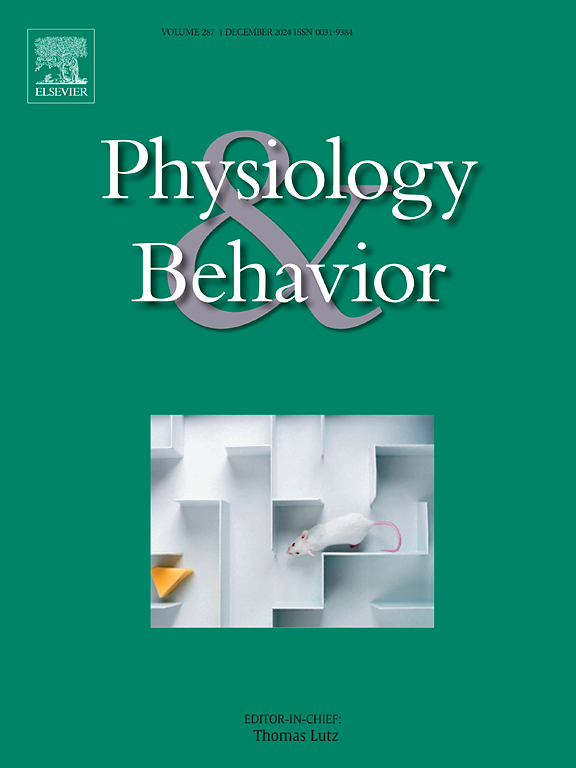冷水浸泡对健康成人能量消耗、随意能量摄入和食欲的影响
IF 2.4
3区 医学
Q2 BEHAVIORAL SCIENCES
引用次数: 0
摘要
冷水浸泡是一种流行的方法,通常用于减少运动引起的肌肉损伤,改善健康和福祉。尽管有这些好处,但越来越多的证据表明,暴露在水中的温度会影响接下来几个小时的能量摄入。本研究旨在探讨水温对静息成人能量消耗和浸泡后自由能量摄入的影响。参与者有不同的体重,但健康且身体活跃的男性(n = 10)和女性(n = 5),在重复测量交叉设计中参加了三个随机试验,间隔至少7天。参与者在冷水(16°C)、热中性水(35°C)或无水的热中性环境空气控制(26°C)中浸泡至胸骨高度30分钟。参与者在整个过程中完成了与食欲相关的视觉模拟量表,并被提供了一份随意的同质意大利面,并被要求吃到“舒服地吃饱”。结果重复测量方差分析显示,受试者在冷水中(2783±909 kJ)比热中性水(1817±862 kJ)和热中性环境空气(1894±233 kJ)浸泡后消耗更多的能量。在食欲VAS上没有任何差异。在整个试验中,浸泡30分钟后,核心温度保持稳定,但与热中性水相比,冷水浸泡15分钟后,观察到核心温度下降。0.001)和热中性空气(P = 0.004)。虽然确切的机制尚未阐明,但需要进一步的研究来确定核心温度的下降是否是冷水浸泡后补偿性食物摄入的潜在机制。结论:与热中性水浸泡和热中性环境空气浸泡相比,冷水浸泡后直接提供自由餐的参与者消耗更多。随着冷水浸泡越来越流行,这些发现对个人的体重管理意识具有实际和临床意义。本文章由计算机程序翻译,如有差异,请以英文原文为准。
Effects of cold-water immersion on energy expenditure, ad-libitum energy intake and appetite in healthy adults
Introduction
Cold-water immersion is a popular method typically used to reduce exercise induced muscle damage and improve health and wellbeing. Despite these benefits, there is emerging evidence to suggest the temperature of the water exposure can influence energy intake in the subsequent hours. The study aim was to investigate the influence of water temperature on energy expenditure and post-water immersion ad-libitum energy intake in resting adults. Participants with a range of body masses, but otherwise healthy and physically active males (n = 10) and females (n = 5), participated in three randomised trials in a repeated measures crossover design, with a minimum of 7-days apart. Participants were immersed to sternum level for 30-minutes in either cold-water (16 °C), thermoneutral-water (35 °C) or a no-water thermoneutral ambient air control (26 °C). Participants completed appetite related visual analogue scales throughout and were presented with an ad-libitum homogenous pasta meal and asked to eat until ‘comfortably full’.
Results
Repeated measures ANOVA showed participants consumed more energy after immersion in cold-water (2783 ± 909 kJ) versus both thermoneutral-water (1817 ± 862 kJ) and thermoneutral ambient air (1894 ± 233 kJ). There were no differences in any of the appetite VAS. Core temperature remained stable throughout the 30 min immersion period across trials, however an after-drop in core temperature was observed for 15 mins following cold-water immersion when compared to both thermoneutral water (P < 0.001), and thermoneutral air (P = 0.004). Although the exact mechanisms are yet to be elucidated, further research is required to identify if the after-drop in core temperature is a potential mechanism responsible for compensatory food intake post cold-water immersion.
Conclusion
When presented with an ad-libitum meal directly after cold-water immersion, participants consumed more in comparison to both thermoneutral water immersion and thermoneutral ambient air. With cold water immersion becoming popular, these findings have practical and clinical relevance for individuals’ conscious about body mass management.
求助全文
通过发布文献求助,成功后即可免费获取论文全文。
去求助
来源期刊

Physiology & Behavior
医学-行为科学
CiteScore
5.70
自引率
3.40%
发文量
274
审稿时长
47 days
期刊介绍:
Physiology & Behavior is aimed at the causal physiological mechanisms of behavior and its modulation by environmental factors. The journal invites original reports in the broad area of behavioral and cognitive neuroscience, in which at least one variable is physiological and the primary emphasis and theoretical context are behavioral. The range of subjects includes behavioral neuroendocrinology, psychoneuroimmunology, learning and memory, ingestion, social behavior, and studies related to the mechanisms of psychopathology. Contemporary reviews and theoretical articles are welcomed and the Editors invite such proposals from interested authors.
 求助内容:
求助内容: 应助结果提醒方式:
应助结果提醒方式:


